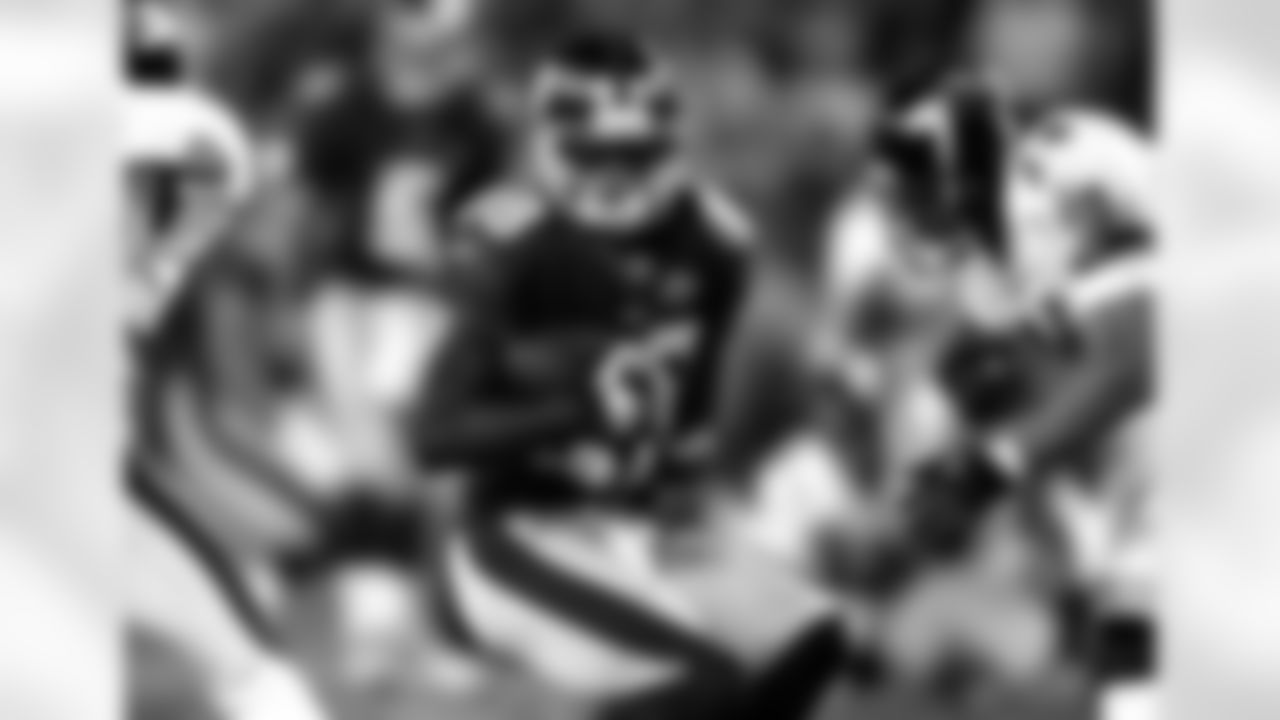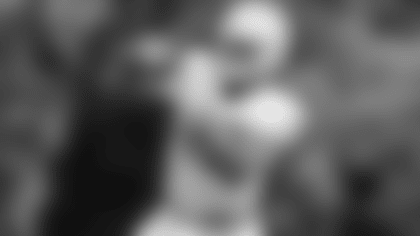With the Los Angeles Chargers picking seventh in the 2017 NFL Draft, here are the 25 most recent players selected with the number seven overall pick.

San Francisco 49ers rookie defensive end DeForest Buckner (99) gets set for the snap in a three point stance during the 2016 NFL week 16 regular season football game against the Los Angeles Rams on Saturday, Dec. 24, 2016 in Los Angeles. The 49ers won the game 22-21. (Paul Spinelli via AP)

Dallas Cowboys wide receiver Lucky Whitehead (13) lines up against the Dallas Cowboys in an NFL football game, Sunday, Sept. 25, 2016, in Arlington, Texas. (AP Photo/LM Otero)

Tampa Bay Buccaneers wide receiver Mike Evans (13) runs upfield with a pass against the Atlanta Falcons in a Thursday Night NFL football game Nov. 3, 2016 in Tampa, Fla. The Falcons won 43 - 28. (Al Messerschmidt via AP)

Arizona Cardinals guard Jonathan Cooper (61) against the Cleveland Browns in the first half of an NFL football game, Sunday, Nov. 1, 2015, in Cleveland. (AP Photo/Ron Schwane)

Safety Mark Barron (23) of the Tampa Bay Buccaneers sets for play against the Minnesota Vikings October 26, 2014 at Raymond James Stadium in Tampa. The Vikings won 19 - 13. (AP Photo / Al Messerschmidt)

San Francisco 49ers linebacker Aldon Smith (99) reacts after a play against the Baltimore Ravens during the third quarter of the NFL Super Bowl XLVII football game, Sunday, Feb. 3, 2013, in New Orleans. (AP Photo/Dave Martin)

Cleveland Browns cornerback Joe Haden (23) chases the action during the NFL week 10 regular season football game against the Cincinnati Bengals on Thursday, Nov. 6, 2014 in Cincinnati. The Browns won the game 24-3. (AP Photo/Paul Spinelli)

Oakland Raiders wide receiver Darrius Heyward-Bey (85) gets past Kansas City Chiefs cornerback Stanford Routt (26) for a touchdown during the second half of an NFL football game at Arrowhead Stadium in Kansas City, Mo., Sunday, Oct. 28, 2012. (AP Photo/Ed Zurga)

New Orleans Saints defensive tackle Sedrick Ellis (98) lines up in a four-point stance during an NFL game against the Oakland Raiders on November 18, 2012. The Saints defeated the Raiders 38-17. (AP Photo/Kevin Terrell)

Minnesota Vikings running back Adrian Peterson (28) tries to break a tackle by Chicago Bears free safety Chris Conte (47) during overtime of an NFL football game, Sunday, Dec. 1, 2013, in Minneapolis. The Vikings won 23-20. (AP Photo/Ann Heisenfelt)

Oakland Raiders safety Michael Huff (24) reacts during an NFL football game against the Atlanta Falcons, Sunday, October 14, 2012, in Atlanta. The Falcons won 23-20. (AP Photo/Paul Abell)

CHICAGO, IL - OCTOBER 14: Wide receiver Troy Williamson #82 of the Minnesota Vikings runs a pass pattern against the Chicago Bears at Soldier Field on October 14, 2007 in Chicago Illinois. The Vikings defeated the Bears 34-31. (AP Photo/Scott Boehm)

Detroit Lions wide receiver Roy Williams (11) bobbles a pass during an NFL game against the San Francisco 49ers, Sunday, Sept. 21, 2008 in San Francisco. (AP Photo/Greg Trott)

Quarterback Byron Leftwich #7 of the Jacksonville Jaguars throws a pass against the Green Bay Packers at Lambeau Field on August 23, 2007 in Green Bay, Wisconsin. The Jaguars beat the Packers 21-13. (AP Photo/David Stluka)

Minnesota Vikings offensive tackle Bryant McKinnie (74) blocks during the NFL week 10 football game against the Chicago Bears on Sunday, November 14, 2010 in Chicago, Illinois. The Bears won the game 27-13. (AP Photo/Paul Spinelli)

Linebacker Andre Carter #96 of the San Francisco 49ers comes around the end against the Houston Texans at Monster Park on January 1, 2006 in San Francisco, California. The Niners defeated the Texans 20-17 in overtime. (AP Photo/Paul Spinelli)

Arizona Cardinals running back Thomas Jones races with a swing pass from quarterback Dave Brown for a 19-yard gain to the San Diego Chargers' 2-yard line during the second quarter Friday, Aug. 25, 2000, in San Diego. The Cardinals were unable to score. (AP Photo/Lenny Ignelzi)

Washington Redskins defensive back Champ Bailey (24) on Sunday, September 22, 2002, in San Francisco, California. The 49ers defeated the Redskins 20-10. (AP Photo/Al Golub)

New Orleans Saints offensive tackle Kyle Turley (68) is seen in action during an NFL game against the Carolina Panthers Oct. 14, 2001 in Charlotte, N.C. (Allen Kee via AP)

New York Giants wide receiver Ike Hilliard (88) runs upfield with the ball during Super Bowl XXXV Jan. 28, 2001, at Raymond James Stadium in Tampa, Fla. The Baltimore Ravens defeated the New York Giants 347. (Allen Kee via AP)

New England Patriots wide receiver Terry Glenn (88) carries the ball during an NFL football game against the San Diego Chargers at Foxboro Stadium on August 31, 1997 in Foxboro, Massachusetts. The Patriots won 41-7. (AP Photo/David Stluka)

Philadelphia Eagles defensive end Mike Mamula (59) is seen in action during an NFL game against the Arizona Cardinals Sept. 10, 1995, in Glendale, Ariz. (Kevin Terrell via AP)

San Francisco 49ers vs. Philadelphia Eagles at Candlestick Park Sunday, December 29, 1996. 49ers beat Eagles 14-0. San Francisco 49ers defensive tackle Bryant Young (97). (AP Photo/Al Golub)

Chicago Bears Curtis Conway (80) during a game from his 1993 season. Curtis Conway played for 12 years with 4 different teams.(David Durochik via AP)

Miami Dolphins' Troy Vincent (23) intercepts a Steve Bono pass to Kansas City Chiefs' J.J. Birden in the end zone during second quarter action in Miami, Fla., Dec. 12, 1994. (AP Photo/Lynne Sladky)
Chargers General Manager Tom Telesco was at StubHub Center on Monday to hold his annual pre-draft press conference. The Bolts enter Thursday night with a total of seven draft picks, beginning with the seventh overall selection in round one.
With that in mind, here are seven things we learned from Telesco about the Chargers' draft plans:
1. The Lynn Factor –Head Coach Anthony Lynn's arrival means the Bolts are drafting players to fit a different system for the first time in the Telesco era. As such, Lynn and his staff are in constant communication with the scouts, identifying the qualities they covet in a prospect. So, don't be surprised if there are different types of players higher on the team's draft board than previous years based on Lynn's system:
"(From) what I've seen from the new coaches, they've been (number one) good evaluators, and number two, most importantly, they can really communicate to us what they're looking for. That's really important for any scout and any GM; that the coaches know exactly the traits that fit the scheme that they want to run and be able to explain that really easily to us. So when we're on the road looking for players, we can see right away if we think a guy is going to fit or not. A lot of the draft is eliminating the players who don't fit for you either scheme-wise or culture-wise. (You) try to narrow down that list. When we start off, there's probably 3,000 prospects and the end amount, we're probably looking at under 200 as far as on draft day that we're drafting out of."
2. Debates Rage On –Just because the scouts and coaches work closely together doesn't mean they always see eye to eye. The GM explained there have been lively discussions going on in the war room, which will continue in the days to come. Telesco gave an inside peek into what the meetings are like behind closed doors:
"There's always back and forth. The only good thing is when you close the door, you can have really frank discussions on things. We're all football people so sometimes you can get a little bit heated when you're talking about football and being competitive. There's also some professional humility, too. To be able to work with everybody and not everybody has the answer all the time. But they're really fun discussions and every time you have a new coaching staff or new coach and different wrinkles in things they look for, our scouts go on the road and (on) a very broad base, scout every position from top to bottom. We'll narrow that down as we get closer, but they're always really good discussions. Sometimes scouts have a broader look on things; coaches a little bit more narrow as far as who can help them tomorrow. But that's needed in your checks and balances. That's kind of the way we set things up to have different filters through our whole process and try to get more right than you get wrong."
3. Rivers Succession Plan –Whether or not the Chargers will select a quarterback in this year's draft has been top of mind for draft pundits around the country. With Philip Rivers entering his 14th season, it's only natural to wonder if this is the year the Bolts add a quarterback to the roster. Telesco explained how the team puts a significant amount of work into the position every year, and while he doesn't know if they will select one come this weekend, the Bolts will be prepared for whenever the day they decide to pull the trigger comes:
"Since I've been here, we've put as much work in the quarterback as we have with every other position. It doesn't matter if your franchise quarterback is 25 or 35; it's a position you have to know inside and out because it's so important to have. It's an asset to have. We've done that same amount of work this year. Whether it lines up in this draft or not, I don't really know. Whether it lines up in next year's draft in 2018 or 2019, I don't really know. But I know we'll be prepared with the work we've done in case that arises."
4. How Depth Impacts Decisions –Depth at each position plays a key role in who the Chargers will select when on the clock. If the team is deciding between a pair of prospects they have equal grades on, the player at a position with less depth will often get the nod according to Telesco:
"We call it draft management. Obviously, if there was one position that was very strong say in the third and fourth rounds and another position that wasn't as strong. Then maybe you had two players ranked but one guy was a lot lower, you wouldn't reach down and take a lower player because you could get more guys there later. But where it does mean more is if you have equal rankings of two players at different positions. If you take a guy here, who are we set up for down the road? There's a lot of strategy that goes into it. You're competing with 31 other teams to get the players who you want and inevitably, a lot of players we want are players a lot of other teams want, too. There's a little bit of strategy and gamesmanship to it, but you just try to get as many as you can. You don't get everybody you want. But these are all discussions we'll have way before the draft so on draft day, it's relatively quiet. We've already decided, gone through different scenarios (and) frameworks of what could happen. Draft day is very quiet unless somebody goes off right before we pick that I wanted or we wanted, then I take a tennis ball and throw it against the wall. You snap out of that pretty quick."
5. Medical Concerns –Just like he meets with scouts to discuss a player's on-field talent, Telesco spends ample time with doctors evaluating a player's medical history. Virtually every prospect has some type of injury history, so it is important to get a thorough understanding:
"The medical portion and the work with our doctors is just as important as the work with our scouts. We'll sit in the room with the doctors almost like it's a scouting meeting. We'll go through all the players, what they have, what their risks are, what the short-term risk is (and) what the long-term risk (is). Those are discussions that take a long time. If you're not available for us, you can't help us. But we have to go through and try to make good, educated decisions on injuries. These guys are playing football at the college level. You're going to have injuries, you're going to have previous surgeries and you have to decide if you think it's going to affect them down the road."
6. Late Round Gems –While first-round picks boast the biggest sex appeal, late round selections and undrafted free agents are just as important. Telesco and his staff have put just as much work towards identifying these gems, which in recent years included fifth-round pick Jatavis Brown as well as undrafted free agents like Tyrell Williams, as they do with day one prospects:
"Since we do this all year round, we can use the same amount of time on the seventh round draft picks and college free agents as we do the first round guys. We're able to do that because of our manpower and the number of days we're working. Those fifth, sixth and seventh rounds, those are really important draft picks for the core of your football team so we put a lot of work into that. This past week, with myself, Anthony Lynn and the decision makers, we're really focusing on the first round pick. But everything up to that, you're really working through the whole draft and college free agents."
7. Need vs. Best Player Available –It's a question every general manager is asked in some way, shape or form. Do you go with need or best player available when it's your turn on the clock? It's a tricky question to answer, and a number of factors that go into a decision, but Telesco believes you never pass on the top talent:
"The draft board kind of ends up telling you where to go. We get that stacked, and put a lot of work into it (and) tweaking it, getting it lined up not only vertically, but horizontally. The board will tell us where to go. There are positions on our team we like to add to, but we'll never pass a special player for a need. The draft board will kind of tell us where to go with that. I will say, this year's draft seems a little more defense than offense, but it changes year to year. Sometimes you don't even realize until after the draft where you see where players go. Because we only have players ranked how we see them, not (how) the rest of the league (does). It's hard to say, but we can really use players on both sides of the ball anyway so it works out well."













